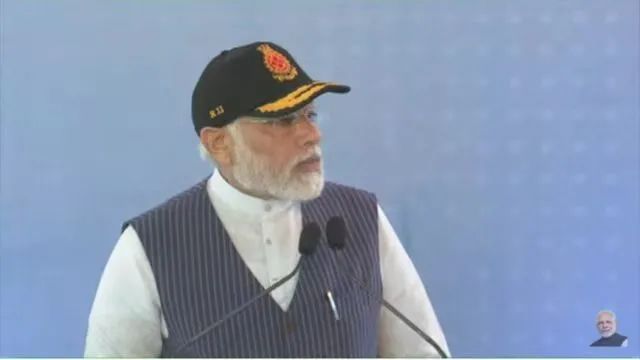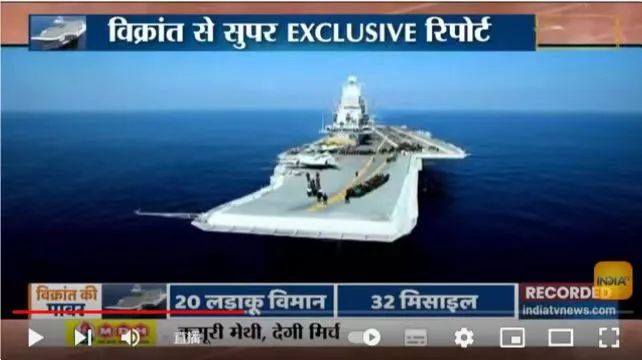It took 17 years to build a bumpy construction, and India's first domestic aerospace mother served
Author:China News Weekly Time:2022.09.03

In view of the status and role of the aircraft carrier
The Indian Navy in the purchase and construction of aircraft carriers
Invest a lot of resources
On the morning of September 2nd, local time, the Indian government held a service ceremony for India's first domestic aircraft carrier "Victor" in Kachin. Indian Prime Minister Modi attended the service ceremony and reviewed the Indian Navy's honor guard.
Modi said at the service ceremony that the "Vikrant" aircraft carrier proved India's determination to promote the "self -reliant India" policy.
With the sequence of medium -sized aircraft carriers built for 17 years to join the Indian Navy's combat sequence, India has become one of the rare countries in the world to establish the most advanced defense technology. The United States CNN said that the service of the "Vikrant" made India officially join the "Aircraft Carrier Club".

Modi attended India's first domestic aerospace service ceremony. Figure/Modi Social Media Video Screenshot
Aircraft carrier "medium student"
India was the first country in Asia to equip the aircraft carrier after World War II. As India's latest aircraft carrier, the Victor was highly hoped by the Indian Navy.
This newly laid-down giant ship has 40,000 tons, which can be equipped with 34 carriers including the MiG-29K carrier-based fighter, card-31 warning helicopter, and MH-60 multi-purpose helicopter. The speed is 18 verses, and the battery life can reach 7,500 nautical miles. The fixed wing carrier carrier carried by the aircraft carrier uses a skid off to block the ship, and sets 2 take -off runways (one of which is about 180 meters long) and a slanting deck. Suo, the sliding deck is up to 14 °, 262 meters long, 62 meters wide, and 59 meters high. It is the biggest and most complicated warship built by South Asian countries to date.

Video screenshot: Indian TV station live broadcast first domestic aerospace mother service
The aircraft carrier is divided into attack aircraft carriers, anti -submarine aircraft carriers, escort aircraft carriers and multi -purpose aircraft carriers according to their missions. Various aircraft including fixed wing aircraft and helicopters, while the latter can only take off and land helicopters or fixed -wing aircraft that can be vertically taken off and land. The navy of some countries also has a vessels with similar appearances, called "amphibious attack ships". It can also take and land and land with helicopters or vertical take -off and landing wings; More than 10,000 tons), medium-sized aircraft carriers (30,000 to 60,000 tons) and small aircraft carriers (less than 30,000 tons); divided into conventional power carrier and nuclear-powered aircraft carriers according to power.
According to the above standards, this aircraft carrier in India is a multi -purpose conventional power medium -sized aircraft carrier equipped with a fixed -wing aircraft. If the American "Ford" -class aircraft carrier is called the nine -segment master, then the Indian aircraft carrier is probably equivalent to the four sections, five, and fifth. The strength of the segment — the level of the carrier -based aircraft can only be said to be barely enough. The take -off method has a large limit on the performance of the carrier -based aircraft, the power method is not advanced, and the displacement is limited. In terms of overall performance, it belongs to the "middle student" level among the world aircraft carriers. Essence However, compared to aircraft carriers in Thailand, Italy and other countries, the Victor still has certain advantages in terms of overall strength.
Difficult to fulfill the dream of "three navigation"
As a maritime force that inherits the geopolitical ideological tradition of the British Empire, the Indian Navy has always paid attention to the section of sea power. The Indian Navy strategy has shifted from offshore defense and regional deterrence to offensive offensive, and has established a reliable sea -based nuclear deterrent capabilities through key development of strategic nuclear submarines and aircraft carriers.
Aircraft carriers have multiple functions and can perform military and non -military tasks such as attack, air defense, anti -ships, anti -submarine, disaster relief, etc., and are effective tools for implementing national will. The carrier -based aircraft on a aircraft carrier can control 800km × 1000km sea airspace. Four nursingmate formations can control about 965,000 square kilometers of large -scale waters. In addition to seizing sea rights and air control, they can also seize electromagnetic rights and systems. Land power, the use of its use of any other weapons is incomparable.
In India's navy strategy, aircraft carriers are a multi -faceted hand. In addition to seizing the vital right to make sea -making power, they can also perform a variety of tasks, including supporting land battlefields, security to defend the safety of maritime traffic, defending vital overseas interests, defending islands for the island. Territory, implementing non -military tasks, etc.
In view of the status and role of aircraft carriers, the Indian Navy has invested a lot of resources in the purchase and construction of aircraft carriers. From the perspective of its home, the "Vikra Maditia" is the only aircraft carrier currently in service before the "Vikrant". This aircraft carrier was originally the "General Gorshkov Navy" of Russia. It is the No. 3 ship of the Kyiv -class aircraft carrier developed by the Soviet era. At 4000 nautical miles, the standard displacement volume is 33,400 tons, the main carrier-based aircraft are 24 Mig-29K carrier-based fighters, 6 card-29/31 or HAL helicopters. Some outdated aircraft carriers. India plans to have an aircraft carrier battle group composed of at least three aircraft carriers by 2020, including the "Vikra Madia" and two other Indian aircraft carriers. The "Vikrant" originally planned to join the fleet in 2017. This medium -sized aircraft carrier with a displacement of 40,000 tons also made India the fourth country in the world with the ability to build an aircraft carrier. Another self -built aircraft carrier will have a larger displacement (64,000 tons). Once India plans to implement their three aircraft carriers, then at least two aircraft carriers are in service to control two Indian Ocean on the Indian Ocean. The key waters of the film -the Bay of Bangladesh and the Arabian Sea, thereby controlling the Indian Ocean.
However, because the Indian domestic aircraft carrier construction plan is very unsuccessful, this "three aircraft carrier plans" are still on paper. Analysts believe that India's second domestic aircraft carrier will not be able to serve around 2040, but the "Vikhamatia" will face retirement around 2030. Therefore, if it is not to buy second -hand aircraft carriers from other countries, India will not be able to fulfill the dream of "three aircraft carriers".
The road to built up
The "Vikrant" aircraft carrier was proud of India. Indian media reported that in addition to the ship building owner Kachin Ship Factory Co., Ltd., more than 50 major industrial groups in India have participated in their construction projects, and more than 500 companies provide supporting services for them. The ship's 23,000 tons of steel, 150 kilometers of pipelines, and more than 2,000 valves are their local products, and combat management system integration, kitchen, air conditioning, steering gear and toilet are also completely domestically produced. Its proportion reaches 76%.
However, it is difficult to hide the embarrassment behind these glorious data. At the end of November 2004, the Indian government announced that the 30 billion rupees (about RMB 2.6 billion) were announced to announce the construction of aircraft carriers at a high profile; in April 2005, the aircraft carrier construction project was officially launched; after 5 years, in 2009, the keel of the aircraft carrier was talented Start laying; two years later, in 2011, the aircraft carrier first went out of the dock. After the water was launched, the aircraft carrier originally planned to complete the internal work and installation operations in mid -2012, and then returned to the dry dock again to install the promotion and power system. Due to the lack of aircraft carrier construction experience in the Kachin Shipyard, the construction progress of the "Vikrant" aircraft carrier was far behind the plan, and a series of accidents occurred during the period. In the second half of 2012, the aircraft carrier returned to the dry dock again to install gearboxes, generators and other equipment. At the end of 2014, the "Victor" aircraft carrier made new progress after a year of silence, and has begun to build a ship island facilities. In May 2015, the Victor aircraft carrier officially laid off for the third time, but the installation project was still slow.
The Indian Parliament Defense Commission pointed out that the cost of the "Vikrant" aircraft carrier has exceeded 2.81 billion US dollars, an increase of 6 times over the initial budget. In July of this year, the "Vikrant" aircraft carrier completed the fourth stage of sea test and entered the list on September 2. The weak industrial foundation, backward management methods, inefficient political systems and ubiquitous corruption are the main reasons for the construction of the aircraft carrier. It is foreseeable that during the next use process, the aircraft carrier may face many challenges.
However, after all, the "Vikrant" is one step closer to India's dream. For a long time, India has implemented a marine security strategy that can be called the "fence" strategy. This "fence" is composed of three concentric semicircular strategic zones extended to the center of India: the first floor is the fully controlled area, that is, the seas within 500 nautical miles of the coast; followed by the middle control zone- The seas within the range of 500 to 1000 nautical miles; the third floor is the soft control area -including all parts of the remaining Indian Ocean. The "fence" is divided into two parts: Mencius-Ting Ke Mari-Koco Island.
Among the three strategic areas, India's most concerned areas are the nearest control zone closest to the sub -mainland, especially the exclusive economic zone extending from the coast to 200 nautical miles. In addition to the exclusive economic zone, the Indian Navy hopes to defend the safety of the waters within 500 nautical miles from the coast. In the medium -control area, the main goal of the Indian Navy is to make the hostile forces invading the area not see the opportunity to win and provide protection for the Indian merchant ships that pass through. Essence In the soft control area, the Indian Navy hopes to monitor the actions of other large navy with large scouts, and this monitoring also needs the support of aircraft carriers when necessary. While the Indian Navy with two aircraft carriers, while the Indian Ocean,, will inevitably collide with the world's ocean overlords in the United States. It can be said that the column of the "Vikrant" may deepen the contradiction between the United States and India's rights and the contradiction between India and Pakistan, and its impact will spill from the military field to the geopolitical field. (The author is deputy director of the Northeast Asia Research Center of Shanghai Political Science and Law School, a special researcher at the South Asian Research Center of Fudan University)
Author: Yang Zhen
Edit: Xu Fangqing
Operation editor: Xiao Ran
- END -
"Welcome to the 20th Celebration of August 1" Shaanxi Province Hanxi Forestry Bureau carried out forest fire extinguishing emergency drills

Green China, August 2 (Li Binqing, a reporter from Rong Media) On August 1st, on t...
[Full Police Practice Big Military Practice] Taking training as a war!Jingmen Traffic Police launched the minimum combat unit on -site disposal skills competition

Hello, I'm a traffic policeman in Jingmen, please shake down the window to coopera...